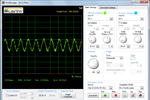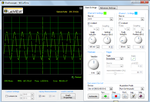anushaas
Member level 5
One key assumption is that this particular part is
pristine. After checking that the supplies are what
you think they are, I'd swap out for another part
and see whether the issue persists, or changes.
A little handling ESD can really whack op amp input
attributes.
I tried using a new AD8041 opamp (as an unloaded buffer) and it also showed the same offset at it's output.However,a LF347(also as unloaded buffer) did not show any such offset.
I shall try using some other opamp with 20MHz GBW as suggested by FvM




